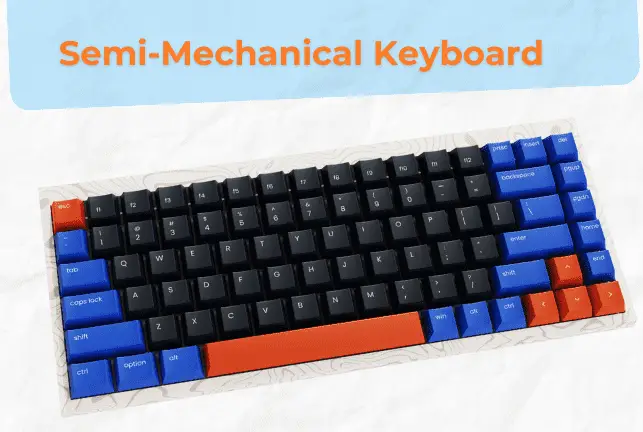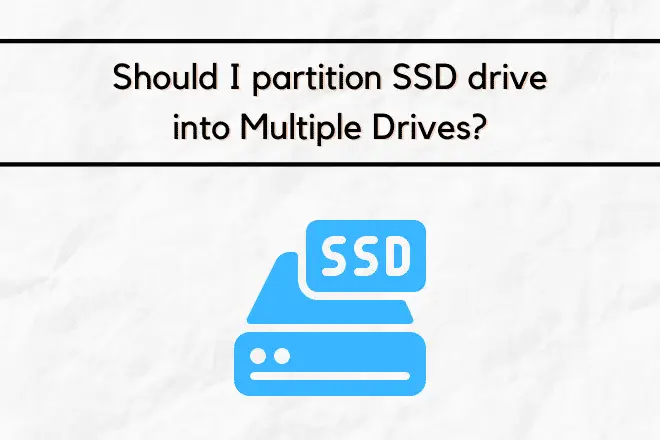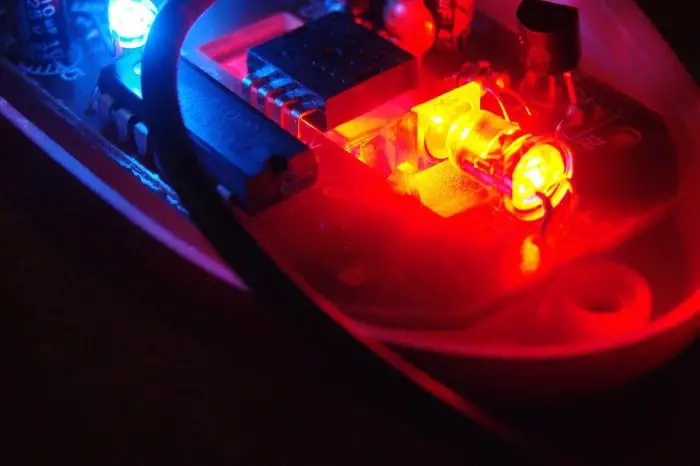When I first heard about semi-mechanical keyboards, I was intrigued. What were they, and how did they differ from the traditional mechanical and membrane keyboards I was familiar with?
Semi-mechanical keyboards, as I discovered, are an interesting hybrid. They aim to offer the best of both worlds: the affordability and quiet operation of membrane keyboards with a nod to the tactile feedback and durability of mechanical keyboards.
What is a Semi-Mechanical Keyboard?

The semi-mechanical keyboard is a hybrid that has the best elements of mechanical and membrane keyboards. These keyboards are designed to cater to users who seek the tactile feedback and durability of mechanical keyboards but at a budget point.
They retain the tactile feel of mechanical keyboards while incorporating elements of membrane technology to reduce cost and noise.
Semi-mechanical keyboards serve as an affordable alternative to fully mechanical keyboards, allowing more users to enjoy the benefits of a tactile and durable keyboard without the high price tag.
How Does a Semi-Mechanical Keyboard Work?
The mechanics of a semi-mechanical keyboard operate by cleverly merging two distinct systems. Let’s break down the components that make this possible.
Membrane Layer
The heart of the semi-mechanical keyboard is the membrane layer. This component is crucial as it serves as the foundation upon which the semi-mechanical system is built. The membrane layer, similar to that of a traditional membrane keyboard, consists of three parts: the top membrane, the spacer, and the bottom membrane.
When you press a key, it pushes these layers together, creating a circuit that registers the keystroke. This setup is cost-effective and contributes to the overall affordability of the keyboard. Yet, what sets a semi-mechanical keyboard apart from its membrane counterpart is its integration of mechanical features to enhance the mechanism.
Mechanical Switches
What sets a semi-mechanical keyboard apart are the mechanical switches integrated into the design. Unlike a fully mechanical keyboard, which has a separate mechanical switch under each key, a semi-mechanical keyboard incorporates a mechanical plunger beneath each keycap.
This plunger mechanism, when pressed, still interacts with the membrane layer to register a keystroke but does so in a way that mimics the tactile feedback of a mechanical switch. This is where the semi-mechanical keyboard truly shines. By integrating these plungers, the keys feel more responsive and provide that satisfying tactile bump and audible click that many users crave in a keyboard.
This innovative hybridization retains the structural simplicity and cost-efficiency of the membrane layer while elevating the tactile experience with mechanical-like feedback.
In essence, a semi-mechanical keyboard cleverly combines membrane and mechanical technologies to deliver a unique typing experience that doesn’t compromise on quality or affordability.
This ingenious blend is what makes these keyboards a compelling choice for users who seek the tactile feedback of mechanical keyboards but are mindful of budget limitations.
Benefits of Using a Semi-Mechanical Keyboard
These hybrids satisfy a wide range of users, from gamers to professionals, by offering a taste of mechanical precision without the hefty price tag.
Affordability is a standout advantage of semi-mechanical keyboards. They provide a cost-effective solution for users who crave the tactile experience of mechanical keyboards but are hesitant about the cost. By integrating both membrane and mechanical technologies, manufacturers are able to keep costs down, making these keyboards accessible to a broader audience.
In terms of performance, semi-mechanical keyboards don’t disappoint. They simulate the tactile feel of their fully mechanical counterparts quite effectively, which is particularly impressive. This mimicked tactile feedback not only enhances the typing experience but can also lead to a potential improvement in typing speed and accuracy.
Moreover, semi-mechanical keyboards tend to offer better durability than standard membrane keyboards. While they might not reach the lifespan of traditional mechanical keyboards, they certainly stand up to more wear and tear than their membrane counterparts.
Another aspect I appreciate is the reduced noise level compared to full mechanical keyboards. While they do produce a pleasing, clicky sound that many users enjoy, it’s noticeably less loud.
The appeal of these type of keyboards extends to their design flexibility as well. Some semi-mechanical models come with customizable backlighting and keycap options, allowing users to personalize their setup without diving into the more niche and often more expensive customizations available with mechanical keyboards.
Drawbacks of Semi-Mechanical Keyboards
While Semi-Mechanical Keyboards offer an appealing balance between cost and performance, there are some potential drawbacks that users like me should be aware of. One of the first issues is the limited customization options.
Unlike fully mechanical keyboards, semi-mechanical ones often don’t allow for swapping out switches or modifying keycap designs. This limitation can be a major downside for those of us who love to personalize our typing experience down to the smallest details.
Another concern is the phenomenon of key wobble. Some semi-mechanical keyboards have keys that feel less stable, creating a typing experience that doesn’t quite measure up to the solid feel of fully mechanical models. For someone who prioritizes precision and comfort during long typing sessions, this can be a significant drawback.
Additionally, the complexity of maintaining and repairing semi-mechanical keyboards can’t be ignored. Their hybrid nature, bridging membrane, and mechanical technologies may lead to increased maintenance challenges.
This complexity means that repairs could be more complicated and potentially more costly, especially when compared to straightforward membrane keyboards.
Main differences between Semi-Mechanical Keyboard and traditional mechanical keyboards
To understand the nuances that set semi-mechanical keyboards apart from their fully mechanical counterparts, the table below highlights the main differences.
| Feature | Semi-Mechanical Keyboard | Mechanical Keyboard |
|---|---|---|
| Switch Mechanism | Rubber dome combined with a mechanical plunger for a simulated mechanical feel. | Individual switches beneath each key for authentic tactile feedback and immediate response. |
| Tactile Feedback | Mimicked tactile response closer to mechanical keyboards, offering a satisfying typing experience. | Authentic tactile feedback and distinct clicky response, favored by typing enthusiasts and gamers. |
| Durability | Durable but doesn’t match the longevity and maintenance ease of fully mechanical keyboards. | Built to last, with switches rated for millions of keystrokes, and easier to clean and customize. |
| Affordability | Budget-friendly option with tactile feedback, striking a balance between price and performance. | Higher price tag due to individual switches and build quality, making it a more significant investment. |
| Customization | Limited customization due to integrated rubber dome, offering fewer options compared to mechanical keyboards. | Extensive customization options including switch swapping, keycap changes, and case modifications for personalized typing experience. |
| Typing Experience | Casual typists and budget-conscious gamers seeking tactile feedback without the premium price of mechanical keyboards. | Typing enthusiasts, gamers, and professionals prioritizing premium typing experience and willing to invest in a higher-quality keyboard. |
| Ideal For | Casual typists and budget-conscious gamers seeking tactile feedback without the premium price of mechanical keyboards. | Typing enthusiasts, gamers, and professionals prioritizing premium typing experience and willing to spend in a higher-quality keyboard. |
Final Thoughts
Deciding on whether a semi-mechanical keyboard is the right fit for you comes down to weighing its unique blend of affordability and functionality against its drawbacks.
While they offer a middle ground in terms of price and performance, it’s crucial to consider limitations like customization limitations, and the keys’ stability issues for longer working hours.
If you’re after a cost-effective option that still delivers a satisfying typing experience, a semi-mechanical keyboard is what you’re looking for. But remember, it is not a complete replacement for a fully mechanical keyboard, and it may not meet the demands of heavy typists or those who prefer ultimate customization.
Related Posts:
- Pros and Cons of Mechanical Keyboard over Normal Keyboard.
- What is the Menu Key on the Keyboard? What does it do?
- Top 7 Gaming mouse for Beginners (Entry Level Gamer).
- Why is My Keyboard and Mouse is Not Working? (9 Ways to Fix)





